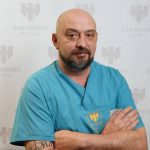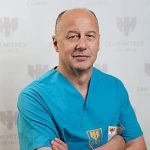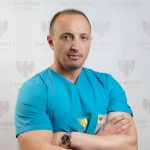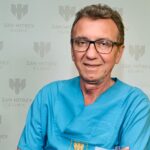 00389 2 3091 484
00389 2 3091 484
Medical services
Orthopedics and Traumatology
Surgeries
- Bone surgery (fractures, osteotomy, biopsy and treatment of malignant neoplasms, amputations)
- Arthroplasty, including hemiarthroplasty and total joint arthroplasty
- Soft tissue surgery, tendons, facias (biopsies and excisions)
- Arthroscopy, arthrotomy, arthrodesis
- Surgery of joint cartilage and ligaments
- Reconstruction of congenital and acquired bone and joint deformities
- Spine surgery
- Surgery of bones, soft tissues, and joints of children

Sports traumatology
Sports and physical activities, and even simple everyday activities can injure ligaments, tendons, and muscles.
- Luxations (distortions)
- Distensions
- Contusions
- Tendonitis
- Bursitis
- Exertion related injuries
Luxations
Most mild luxations recover by applying the so called “R.I.C.E.” (rest, ice, compression, and elevation) and exercise. Moderate dislocations can also require a period of support. The most severe luxations may require surgery to repair the torn ligaments.
Distensions
Distensions are a result of an injury of a muscle or a tendon. It can be a simple strain of the muscle or the tendon, it can be a partial or complete tear of a muscle and tendon combination.
The recommended treatment is similar to luxations: rest, ice, compression, and elevation. This should be accompanied with simple exercises to relieve the pain and restore mobility.
In case of a severe tear, the soft tissues might have to be repaired surgically.
Contusions
Contusion is bruising caused by hitting the muscle, tendon, or ligament. The bruise is caused when the blood collects around the injury and changes the color of the skin.
Most contusions are mild and respond very well to rest, application of ice, compression, and elevation of the injured part.
More severe contusions require medical assistance in order to prevent permanent damage to the soft tissues.
Tendonitis
Tendon inflammation or an inflammation of the tendon lining is called tendonitis. Tendonitis is caused by a series of small repetitive strains that gradually aggravate the situation.
Professional athletes are susceptible to tendonitis in their shoulders and hands.
Tendonitis can be treated with rest in order to eliminate stress, anti-inflammatory medications, steroid injections, immobilizations, and exercises to repair muscle disbalance and improve flexibility.
Enduring inflammation can cause damage to the tendon which may require surgical correction.
Bursitis
Bursa is a sac filled with fluid located between a bone and a tendon or a muscle. The bursa enables the tendon to slide smoothly over the bone.
Repetitive small stresses and overuse can cause swelling of the bursa in the shoulder, elbow, hip, knee, or joint. This swelling or irritation is called bursitis.
Bursitis can usually be alleviated with rest and possibly anti-inflammatory medications. Some orthopedic surgeons also inject additional drugs in the bursa in order to reduce the inflammation.
Bone fractures
Small bone fractures can happen when one of your bones gets stressed from overuse. The injury is called stress fracture.
Initial symptoms include pain and swelling in the area of the stress fracture. The sheen bones and the bones in the foot are especially susceptible to stress fractures.
The fracture may not be visible on the initial x-ray images, thus requiring bone scanning in order to obtain a diagnosis.
These injuries can be treated with change of activities, immobilization with casting, and in the event of more complex fractures, surgical treatment may also be required.

Prosthetic joint replacement
Total joint replacement is a surgical procedure involving the removal and replacement of an arthritic or damaged joint with a metal, plastic, or a ceramic device called a prosthesis. The prosthesis is designed to replicate the movement of a normal, healthy joint.
Surgical procedure
During surgery, the damaged cartilage and bone is removed from your joint and is replaced with prosthetic components made of metal, plastic, or ceramic. The prosthesis imitates the form and the movement of the natural joint. The total joint replacement surgery lasts several hours.
Most of the patients can perform everyday activities more easily after the total joint replacement surgery. Most people can expect their joint replacement to last for many years, providing them with an improved quality of life including less pain, as well as improved movement and strength that would otherwise be impossible.

Contusion
A contusion is a bruise caused by a blow to your muscle, tendon, or ligament. The bruise is caused when blood pools around the injury and discolors the skin.
Most contusions are mild and respond well when you rest, apply ice and compression, and elevate the injured area.
If symptoms persist, medical care should be sought to prevent permanent damage to the soft tissues.
Orthopedic surgeries in children
CEREBRAL PARALYSIS
Cerebral paralysis (CP) is a disorder that affects the ability of the child to control its muscles. It is caused by injuries or abnormalities in parts of the brain responsible for movement and coordination.
Early treatment, such as physical therapy, medications, support, and other devices can significantly help children improve their functional abilities.
Types of cerebral paralysis
There are four main types of cerebral paralysis. Physicians can usually diagnose the cerebral paralysis type when the child is about 2 years of age.
Other cerebral paralysis related disorders
In addition to affecting muscle and motor skills, cerebral paralysis can also cause other disorders in some children. These include:
- Mental disorder (such as intellectual impairment or learning impairment)
- Eyesight impairments
- Shortened limbs
- Curved spine (scoliosis)
- Teeth related problems
- Complete or partial hearing loss
- Problems with the joints (contracture)
Nonsurgical treatment
- Physical therapy
- Support, immobilizers (splints) and casts
- Botox
- Medications
Surgical treatment
If the contractures are severe, then surgery to extend the affected muscles can improve the ability of the child to walk and talk. This surgery can also help if the severely tightened muscles cause stress on the joints and lead to deformities or dislocations.
Some children with cerebral paralysis need surgery in order to be able to properly position their arms or legs or to correct their spine curvature (scoliosis).
Severe spasticity or rigidity of the muscles can be helped by an intrathecal baclofen pump. In this procedure, a small pump is surgically implanted under the skin to deliver doses of muscle relaxant.
In other treatments are not able to effectively deal with the severe spasticity, then a selective dorsal rhizotomy can be performed, which is an exceptionally rare procedure.

Treatment of broken bones
Fracture is a broken bone. A bone can break completely with one clean break, or it can break into several fragments. The break can be longitudinal, transversal or combined when the bone breaks into several pieces.
Types of fractures
The most common types of fractures include:
- Stable fracture. The ends of the broken fragments are in a line and are barely dislocated from their normal position.
- Open, complex fracture. The skin may be ruptured by the bone or by an impact that tears the skin at the time of the fracture. The bone may or may not be visible in the wound.
- Transversal fracture. This type of fracture has a horizontal fracture line.
- Oblique fracture. This type of fracture is at an angle.
- Comminuted fracture. In this type of fracture, the bone breaks into three or more pieces.
The most common reasons for fractures are the following:
- Trauma. A Fall, a motor vehicle accident, or a tackle while playing sports can result in fractures.
- Osteoporosis. This disorder weakens the bones and makes them more fragile.
- Overuse. Repetitive movements can tire the muscles and transfer a greater force onto the bone. This can result in stress fractures. Stress fractures are more common in athletes.
Treatment
- Cast immobilization – gypsum or glass fibers (glass wool) are the most common type of treatment of a fracture since most broken bones can successfully heal when they are properly repositioned and whenever they are immobilized with a cast in order to hold the broken fragments in the proper position until the fracture heals.
- A functional cast or brace enables a limited or “controlled” movement of nearby joints. This treatment is preferable for some, but not for all fractures.
- Pulling – pulling is usually applied to set the bone in a proper position by gently and softly pulling.
- External fixation – this type of surgery involves the placement of metal rods or bolts in the broken bone above and under the fracture site. The rods and bolts are connected with a metal rod outside of the skin. This device is a stabilizing frame that holds the bones in the proper position while they heal. If the skin and other soft tissues around the fracture are heavily damaged, an external fixator may be applied in order for the patient to tolerate the surgery.
- Open reduction and internal fixation are surgical treatments where the bone fragments are repositioned (reduced) in their proper position and then they are held together with special screws or plates affixed on the outside surface of the bone. The fragments can be also held together by placing interlocking nails through the bone.
Bone tumors
A tumor is a tissue mass formed when cells divide uncontrollably. It can weaken the bone, causing it to break (fracture).
Most bone tumors are noncarcinogenic (benign). Some are cancerogenic (malignant). Benign tumors usually are not life-threatening. Malignant tumors can spread the cancer cells throughout the body (in the form of metastases). This occurs through the blood or the lymph system.
Most common benign bone tumors
- Fibroma – unicameral (simple) cyst that does not transform into bone tissue
- Osteochondroma
- Giant cell tumor
- Enchondroma
- Fibrotic dysplasia
Most common malignant bone tumors
- Multiple myeloma
- Osteosarcoma
- Ewing sarcoma
- Chondrosarcoma
Diagnostics
- X-Ray imaging
Magnetic Resonance Imaging - Computer tomography
- Needle tumor biopsy (performed using x-ray, computer tomography or magnetic resonance).
- Open tumor biopsy (taking a sample of the tumor in the operating room)
Non-surgical treatment
– Benign tumors
In many cases benign tumors should only be followed. Some can be effectively treated with medications. Some benign tumors will disappear in time. This especially applies to some benign tumors occurring in children.
– Malignant tumors
Radiation therapy
Radiation therapy uses high dose x-rays to kill cancer cells and reduce tumors.
Systemic treatment (chemotherapy)
This treatment is usually used to kill tumor cells when they have spread into the bloodstream, but still cannot be detected with tests or scans. Chemotherapy is generally used when the cancerogenic tumors have a great likelihood of spreading.
Generally, malignant tumors are removed surgically. Radiation therapy and chemotherapy is usually applied in combination with the surgery.
Surgical treatment
– Benign tumors
Certain benign tumors can spread or become cancerogenic (metastasized). Sometimes, removal (resection of the tumor can be recommended) or specific treatment techniques to reduce the risk of fracture or disability. Some tumors can reoccur, even a few times, after an appropriate treatment.
– Malignant tumors
Limb saving surgery
This surgery removes the cancerogenic part of the bone, but retains the nearby muscles, tendons, nerves, and blood vessels. If possible, the surgeon will completely remove the tumor, as well as part of the healthy tissue around it. The removed bone is replaced with a metal implant (prosthesis) or a bone transplant.
Amputation
Amputation involves the complete or partial removal of the arm or the leg when the tumor is large and/or affects the nerves or blood vessels.
Arthroscopy
Arthroscopy is a surgical procedure used by surgeons to visualize, diagnose, and treat changes within a joint.
During an arthroscopic examination, the surgeon makes a small incision in the skin of the patient, then places pen-size instruments that have small lenses and an illumination system in order to magnify and illuminate the joint structure.
By connecting the arthroscope with a miniature camera, the surgeon can see inside the joint through this small incision, rather than through a large incision that would be required for surgery.
The most common conditions identified during arthroscopic examinations of the joints are the following:
Inflammations and acute or chronic injuries
- Shoulder: Rotator cuff tendon tear, shoulder impingement syndrome, and repeated luxations
- Knee: Meniscus (cartilage) tear, chondromalacia (fatigue or injury of the cartilage cushion) and the anterior cruciate ligament tear with instability
- Wrist: Carpal tunnel syndrome
- Loose bone fragments and/or cartilage: for example: knee, shoulder, wrist or ankle
Procedures involving a combination of arthroscopy and surgery:
- Rotator cuff surgery
- Repair or resection of torn cartilage (meniscus) of the knee or shoulder
- Reconstruction of the anterior cruciate ligament in the knee
- Removal of an inflamed membrane (Baker’s cyst) in the knee, shoulder, elbow, wrist, ankle
- Carpal tunnel release
- Repair of torn ligaments
- Removal of loose bone fragments or cartilage in knee, shoulder, elbow, wrist, ankle.
Arthroscopic surgery, although much easier with respect to recovery than, an “open” surgery, still requires the application of anesthetics and special equipment in the operating room.
A small incision is made (approximately as big as a buttonhole) in order to insert the arthroscope. Several other incisions may be made in other parts of the joint in order to insert other instruments.
When indicted, corrective surgery is performed using specially designed instruments placed in the joint through ancillary cuts. With the development of better instruments and surgical techniques, many conditions may be treated arthroscopically.
Other doctor’s from this department
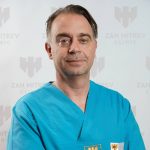
Prof. Konstantin Mitev MD PhD
Spec. in general surgerySubspec. trauma surgeon
konstantin.mitev@zmc.mk
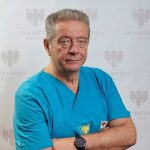
Prof. Slavcho Stojmenski MD, PhD
Spec. in general surgery Sub spec. after traumatology
slavcho.stojmenski@zmc.mk



